3 Bridge Street, Guildford, GU1 4RY
Early Electronic Arts games used to include a high minded mission statement on the inlay:
"We're an association of electronic artists who share a common goal. We want to fulfil the potential of personal computing. That's a tall order, but with enough imagination and enthusiasm, we think there's a good chance for success. Our products, like this one, are evidence of our intent."
It's present on EA's first UK game, PHM Pegasus, but (unfortunately for irony) I can't find any examples of it being used on Bullfrog games because, famously, Electronic Arts killed Bullfrog. The paradox of course is that EA only wanted the best for Bullfrog and without their patronage we'd never have seen Populous, Syndicate, Magic Carpet, Theme Park, Theme Hospital, or Dungeon Keeper. EA nurtured Bullfrog. EA grew Bullfrog. EA supported Bullfrog. EA killed Bullfrog.
EA nurtured Bullfrog
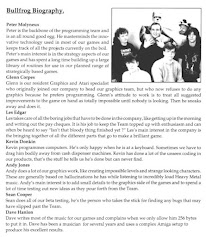 |
| Populous Atari ST Manual |
In 1984 Peter Molyneux had written and marketed a game called The Entrepreneur. The game was written for the BBC Micro and sold through a company called Vulcan Computing based at 32 Guildford Road, Farnham (a residential address). The Entrepreneur is lost to history now but it was followed the same year by a Commodore 64 utility called The Composer 64. Neither programme was successful and Peter Molyneux later said The Entrepreneur sold two copies.
 |
| The Entrepreneur ACORN USER May 1984 page 100 The Composer 64 COMMODORE USER May 1984 page 64 |
Peter Molyneux met Les Edgar at a shop called PJ Hi-Fi and, as he later told RETRO GAMER:
Les suggested we start a company up. I had met this girl at a wedding – a previous girlfriend – and her father was this enormously wealthy bloke who lived in Switzerland. Well, one day I met this girl’s father and he asked me if I’d be interested in a business proposition. The business was exporting money systems – the things that go in slot machines – to Switzerland and baked beans to the Middle East. Of course, being the entrepreneur I was, I accepted
That company was Taurus Impex Ltd (company number 01899947), registered with Companies House in 1985. They were contacted by Commodore Europe who were planning the UK launch of the Amiga. Commodore thought they were dealing with a company called Torus and gave Taurus several Amigas to use as development machines. This happy accident allowed Peter Molyneux to write an Amiga database programme called Acquisition, followed by another utility called X-CAD.
Electronic Arts splashed a little advertising money on Fusion but the game wasn't a commercial success. Wikipedia quotes Glen Corpes (from Rebecca Levine's book Grand Thieves & Tomb Raiders: How British Video Games Conquered the World) describing how Druid II and Fusion "only brought in a fraction of the money needed to pay the wage bill." It was back to the drawing board.
Above is 20 Nugent Road, Surrey Research Park, etc, etc, although it looks a lot like Enigma House. I've got a nagging suspicion I'm missing an address during the two year period covered by Admiral Rodney House. Why? Well for a couple of reasons. First, this picture of Peter Molyneux and Les Edgar from the THE ONE preview of Populous II. The building in the background doesn't look like Enigma House or 20 Nugent Road. Also, let's return to the 1994 interview in THE ONE:
 |
| AMIGA WORLD Special issue 1987 page 3 |
It's 1987. The Amiga was becoming better known as a games machine and Taurus decided to change direction. THE ONE profiled Bullfrog in September 1989 and explained:
So the boys leaped into action and set up Bullfrog with the idea of creating leisure/entertainment software: "We took the name from a ceramic ornament we had around the office."
 |
| AMIGA WORLD December 1987 page 11 |
The first Bullfrog title wasn't a game. It was another utility. A drum machine called A-Drum. It got a very positive review from THE GAMES MACHINE in April 1988:
In short it is an excellent program and I hope it sells in truckloads. It should. Maybe a conversion to Atari would ensure vast fortunes for its designers. Buy one now.
Peter Molyneux was part of round-table programmer interview with THE ONE AMIGA (May 1992 page 20) when the subject of A-Drum came up:
THE ONE: What was the first game you ever wrote, Peter?
PETER: I'm not saying.
PETER: I'm not saying.
THE ONE: Didn't you do some crap BBC stuff?
PETER: Yes, I did a game in the second year of the BBC, but I'm not saying what it is..
ERIC [Matthews, one of the Bitmap Brothers]: Tell us, Peter! Tell us about A-Drum!
PETER: Nooooo!
Andrew Bailey, who worked on A-Drum with Bullfrog's Dave Hanlon, wrote a game called Druid II: Enlightenment. This was published by Firebird, and Andrew Bailey opened the door for Bullfrog to convert the game to the Amiga. Which they did, to pretty good reviews. Druid II: Enlightenment was followed by Bullfrog's first original game, Fusion. THE ONE carried a demo of the game (October 1988 page 7) and in retrospect it's charming how they have to introduce the company to their readers:
Programming team Bullfrog Productions is a new name to the games scene, and Fusion is their first release courtesy of Electronic Arts.
A year later THE ONE (September 1989 page 24) previewed Powermonger and Glen Corpes gave a little background to the development of Fusion:
"We took inspiration from Paul Shirley's Spindizzy, which was my favourite game on the Amstrad. In Spindizzy you had to run over switches to change part of the level near you by opening a secret door or something, so you could get to a different place. I thought that was a brilliant idea, so we incorporated it in Fusion.
So work began in earnest on Fusion, with Glenn designing the graphics and Kevin writing the game code, Five months later an almost complete version was shown to Electronic Arts. "We chose to approach Electronic Arts because we saw that they weren't into conversions or licences," explains Peter, "With the exception of Marble Madness, all of Electronic Arts games are original concepts and that's exactly the type of game that we want to produce."
EA grew Bullfrog
 |
| THE ONE November 1988 page 13 |
The next game was of course Populous which won every review award going. Everyone loved Populous. Well, not quite everyone. I think my favourite comment on the game comes from the lengthy sidebar to the review in AMIGA RESOURCE, in which the reviewer worries over the thorny question of whether the game is blasphemous.
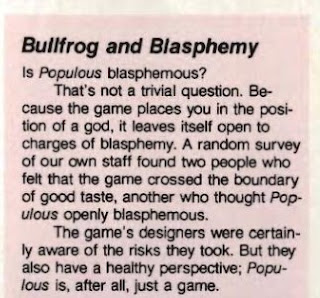 |
| AMIGA RESOURCE October 1989 page 75 |
Preserved at the Internet Archive is an old Edge Online feature (May 2009) on the making of Populous and the difficulty Les Edgar had in finding a publisher:
"We couldn’t sell it to anyone... We tried everybody. While [the team] were in the office, I went off with disks to, I suppose, over a dozen publishers – even the B-, C-, D- and E-list companies. We didn’t go to EA even though we knew them through Fusion [an early, almost entirely forgotten Bullfrog shoot ’em up] because we honestly thought they wouldn’t be interested. Eventually, we put it past Joss Ellis at EA and – to our amazement – he gave us the green light."
The result:
"Our royalty cheques were due to be paid one quarter in arrears, and we didn’t expect to get any,” Les Edgar recalls. “We really were very detached from the quantities sold – we had no idea how big it was. Our first cheque was for £13,000. We agreed to pay off bills, and then think about what to do next. The next cheque was for a quarter of a million. I thought it was a mistake at the time. I actually called EA to tell them. And then Imagineer made an absurdly huge offer for rights to develop it as one of the launch titles for the SNES in Japan."
The question I want answered; with all this money suddenly sloshing around, how long did Bullfrog stay in their original offices? They were apparently not salubrious. In October 1994, THE ONE (again, did the magazine have a secret passage into Bullfrog's offices?) caught Peter Molyneux on fine form as he remembered their first base:
...in the slum areas of Guildford, which consisted of about three houses- I don't think that many people came to our original offices, mainly because they were so rubbish... We were right on the top floor of this crummy old dilapidated building, and we were producing business software. And when you're making business stuff you've got to give the impression that you're a professional software house.
Between us and the ground floor lived this old-age pensioner called Kath, who's now sadly dead. She had severe senile dementia, and because of that she would never recognise anybody who came up the stairs.
The slum area of Guildford has dragged itself upmarket since 1989. I passed through on a Sunday morning and a combination of a narrow road, a tall building, and a surprisingly heavy level of traffic, made it frustrating to try and take a picture. Bullfrog must have been in the dormer windowed attic flat, looking out onto Bridge Street. Note the name of the shop on the ground floor, P.J. hi-fi, where Peter Molyneux met Les Edgar.
Enigma House, 30 Alan Turning Road, Surry Research Park, Guildford, GU2
20 Nugent Road, Surrey Research Park, Guildford, Surrey GU2 5AF
20 Nugent Road, Surrey Research Park, Guildford, Surrey GU2 5AF
Companies House records Bullfrog Productions Ltd as being incorporated on 11 Dec 1989 (a Monday for those planning a horoscope). That's six months after Populous was released and it must be around the time of the second quarter royalty payment for a quarter of a million pounds. Bullfrog is still based at Bridge Street when AMIGA POWER visits in 1991, for an interview printed in the June issue; although the company has expanded to "occupy a number of floors built around a rickety staircase." Bullfrog has moved by the time THE ONE sneak down their secret passage to preview Populous II in the July 1991 issue. Bullfrog, flush with dosh, obviously moved to bigger and better offices around spring/early summer 1991, between the visits by the two magazines, but when exactly did they move? I can't be sure. Companies House records the registered address of Bullfrog as Admiral Rodney House, 17 Church Street, Walton on Thames, from 1989 to February 1993. Bullfrog was always based in Guildford (until it wasn't... read on) so Admiral Rodney House is a blind alley. It was probably the address of a firm of solicitors of chartered accountants who handled the early business affairs of Taurus Impex/Bullfrog.
Where was Bullfrog from 1991 to 1993? That's the question. Here. Probably. Possibly.
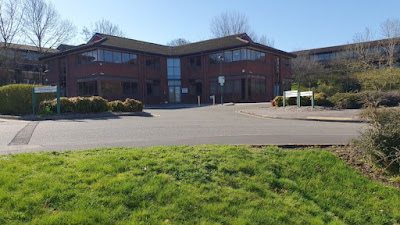 |
| April 2023 |
That's Enigma House on the Surrey Research Park. A squat little rebrick building on an estate full of squat little redbrick buildings. The local architecture is sometimes cited (I can't find any good ones right now and I'm not linking to IMDB trivia as I do have some self-respect) for inspiring the dystopian corporate look of Syndicate.
Companies House records changes of addresses in a slightly cockeyed way. The entry for 11 Feb 1993 in Bullfrog's record reads "registered office changed on 11/02/1993 from: <Admiral Rodney House 17 Church Street Walton on Thames Surrey KT12 2QP". It tells me when Bullfrog registered a change of address and their previous address but not their new one. I need to go up the list to the record dated 26 Sep 1994 to find the next change of registered office address which confirms this was the date Bullfrog recorded a move away from Enigma House. The place they moved to was here:
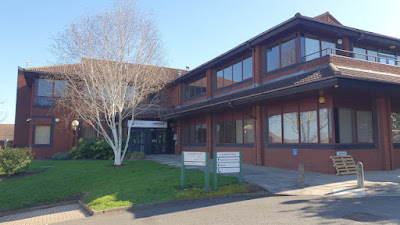 |
| April 2023 |
 |
| THE ONE July 1991 page 42 |
So where did you move to?
The business park. We had a small unit just around the corner from here, which wasn't totally successful either. It was a small business unit, and it had loads of small offices all next to each other. The first day we were in there we left a window open, and burglars got in and ransacked not just our offices but the others as well. So unfortunately we started off being hated completely by our neighbours.
It was very hard, because I don't mind people messing around in the office, after work and stuff. We used to have skateboarding competitions down the corridors, and there was one fad with these little pellet guns, played around the business park. And there were these other businesses trying to do serious work, and us doing barrel-rolls and trying to shoot each other. We were asked to move, eventually, so we moved to another unit nearby.
That interview was printed in October 1994. Given the timeline it must have taken place at 20 Nugent Road, the place Bullfrog moved to after Enigma House. The way Peter Molyneux speaks it doesn't sound like the burglary took place at Enigma House. If Enigma House was the "small unit just around the corner from here," then why does Peter Molyneux describe the office they moved to afterwards as "nearby" instead of "here." I think the sequence goes:
1. 1985 to summer 1991-ish. 3 Bridge Street.
2. Summer 1991-ish to "we were asked to move". Mystery location, the one behind Peter Molyneux and Les Edgar in THE ONE photo.
2. Summer 1991-ish to "we were asked to move". Mystery location, the one behind Peter Molyneux and Les Edgar in THE ONE photo.
3. Profit "We were asked to move" to 26/09/1994 Enigma House. ("another unit nearby").
4. 26/09/1994 and onwards 20 Nugent Road. (THE ONE interview location).
At this point I'd normally waste my decreasing number of precious heartbeats by clicking mindlessly round the Surrey Research Park on Streetview, looking for a building with windows that match the one behind Peter Molyneux and Les Edgar. The snag, the Surrey Research Park isn't on Streetview. Oh bugger. Never mind. Sometimes I get lucky and find a recruitment advert which gives a postal address.
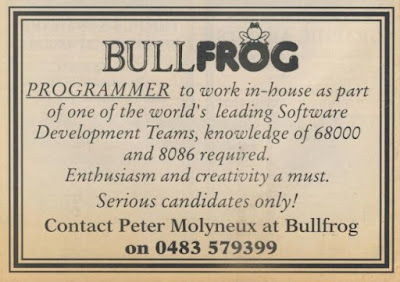 |
| NEW COMPUTER EXPRESS 15 June 1991 page 48 |
Oh bugger.
Alternatively, I could just be overthinking it.
EA supported Bullfrog.
Bullfrog stumbled a little with the release of Powermonger. There's a Gamespot interview with Peter Molyneux (archived now, but I think it dates to 1999) where he discusses the too early release of the game.
The pressure from Electronic Arts for a follow-up to the massively popular Populous caused Bullfrog to release the first version of Powermonger that wasn't buggy.
It's easy to see how a newly successful developer would be susceptible to pressure from their publisher for a quick follow up. To Bullfrog and EA's credit, they both seemed to have learned from the result. If you look at the timeline, EA appear to back off. From the release of Powermonger onwards they give Bullfrog the time needed for the extensive playtesting which was such a large part of what made their games work. You can see the pace of Bullfrog releases slow, after Powermonger, as games are held back until they are ready. Fusion came out in October 1988. Populous in June 1989. Next up was Flood in June 1990, then Powermonger in November of the same year and Populous II a year later in November 1991. And then nothing until June 1993 when Syndicate was released. Then Magic Carpet and Theme Park come in quick succession in May and June 1994.
I loved Magic Carpet. It's not one of Bullfrog's better known games but it got its hooks into me in a way that few games had since my obsessive ZX Spectrum years. I had the PlayStation version and I remember sitting in my room absolutely caning it, to the extent that when I finished it I actually felt guilty about the time I'd put into the game.
EA killed Bullfrog.
In January 1995 EA announced it had acquired Bullfrog; for around £29 million. Speaking to RETRO GAMER (issue 71) Peter Molyneux recalled:
These people kept phoning us and saying, 'If you're ever thinking of selling your company, give us a call. We're very interested.' We didn't take it seriously at first, but then this big companies -Phillips, Electronic Arts- approached us.
Bullfrog rapidly grew from 35 to 150 staff and now managed a conveyor belt of projects which would allow for one release a year. The developer was suddenly exposed to corporate pressures it had previously been able to shrug off.
Peter Molyneux told NEXT GENERATION (October 1997 page 23)
Then, in May '95, they said to me, 'You've got to ship Dungeon Keeper in six and a half weeks.' The game wasn't six months into its development cycle at this point and I said, 'No way.' They said, 'You're a member of the EA family, we need the product, you've got to do it.'
"I was stunned, dumbfounded. This was exactly the sort of thing that they'd promised faithfully would never happen. Because I wasn't prepared to sacrifice DK, I wrote and designed a game from scratch in six weeks: Hi-Octane. But the whole episode was a stunning, shocking, terrible realization that, in fact, we didn't have that much control anymore."
In 2007 Syndicate designer and programmer Sean Cooper told gamedeveloper.com
Hi-Octane, was developed in just eight weeks using the Magic Carpet engine, as a way to “fill a quarter that didn't have enough revenue”. Cooper laughs when asked how he managed to actually achieve the task, though. “Who knows? ‘We'll give you £40k bonus if you get it done’ helped a lot,” he says, smiling wryly.
The Mana House, Unit 1A, Guildford Business Park, Guildford, GU2
 |
| April 2023 |
Tuarus Impex was dissolved on 13 Feb 1996. Peter Molyneux resigned from Electronic Arts in July 1996. He'd been made a company vice-president as part of the Bullfrog acquisition but his new corporate role didn't suit him, as he told Gamespot:
"I thought, 'I still really love games, and I hate what I'm doing at the moment.'" He had two possible choices, either resign from his position and become a full-time designer or resign from the company altogether. He couldn't see himself as an employee at the company he'd started, so he chose the latter. Electronic Arts was understanding and allowed him to terminate his contract, but gave him imposing restrictions during the remainder of his tenure. "They said I couldn't attend any more Bullfrog meetings, and I couldn't see any products. And of course you can't suddenly switch someone off like that. It was hard."
Molyneux would stay on until Dungeon Keeper was finished but development dragged on and on. Gamespot again:
Six weeks before it was scheduled to ship, Molyneux decided the game needed a serious redesign. Faced with another setback, EA told Molyneux that they weren't so sure they wanted to carry on with Dungeon Keeper's development. So Molyneux took the responsibility of the game on himself. "I told EA, 'I'll pay for the game to be finished.' And so the whole team moved into my house and finished the game."
The release of Dungeon Keeper was a moment of transition. The games after it are all sequels; Populous: The Beginning (1998), Dungeon Keeper 2 (1999), Theme Park World (1999), Theme Park Inc (2001). They're not bad games but the imaginative spark has gone.
Companies House records one more move for Bullfrog, in 1996, to an address called The Mana House. Yes, the same stuff you collect in Magic Carpet. The house of magic. A pun on The Manor House. Les Edgar left in 1999. And EA's corporate smothering continued.
2000 Hillswood Drive, Chertsey, Surrey, KT16 0EU
PC ZONE interviewed Bullfrog's programmer Ben Board, associate producer Andy Nuttall, and chief game designer Sean Cooper for "possibly their last interview before the company's mammoth move to EA's rather extravagant new offices in Chertsey - a move that will take Bullfrog out of Guildford for the first time." (May 2000 page 58).
Sean: It does feel like a big deal. There are a lot of people here who are 'Guildford' people through and through. They can practically walk to work at the moment.
Andy: When it was first announced a year ago it was a bit of a shock. We'd been looking at various places to move to, either in Guildford or just south of it - always in this area though.
Andy: When it was first announced a year ago it was a bit of a shock. We'd been looking at various places to move to, either in Guildford or just south of it - always in this area though.
Sean: Personally I think it'll be an awesome move. We're going to have great facilities there and have marketing and PR directly on hand.
Ben: It will definitely be quite a shake-up for everybody concerned.
The tone is supposed to be upbeat but, knowing what happens next, the closing paragraph reads like the opening of a eulogy.
Bullfrog is still very much alive. They may have been going through a quiet patch recently but the attitudes, idealism and passion that existed in the early days is still very much a part of everyone there.
On 17th September 2001 the Companies House register for Bullfrog Productions Ltd records a change of name to Electronic Arts Studio (UK) Ltd. The last game made under the Bullfrog name was released in March 2001. Quake III Revolution for the PlayStation 2. Bullfrog's last title like their first, Druid II: Enlightenment, was a conversion of someone else's game.
EA confesses to killing Bullfrog
Like a two-bit hood with a guilty conscience, EA returned to the scene of the crime. They moved their UK office to Guildford in 2008. You can stand at the junction of Bridge Street and Onslow Street and get a single picture of the first Bullfrog office and the current EA office.
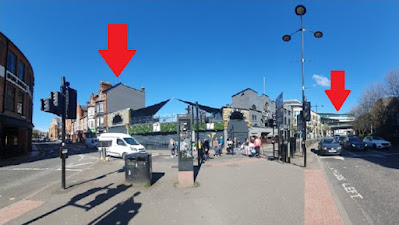 |
| April 2023 |
The same year that EA came to Guildford, CEO John Riccitiello gave a speech at the DICE event in Las Vegas:
The command and conquer model, the command and direct model doesn't work... Bullfrog, Origin, Westwood - all no longer exist today because something broke. ... and I'll simply state that EA blew it, and to a certain degree, since I was involved, I blew it. They told me they were stifled by politics, bureaucracy, and a fact they felt they weren't heard.
Ex-Bullfrog staff who know if I've missed out an address around 1992 can email whereweretheynow@gmail.com or leave a comment. And so can anyone else. I'm still on Twitter @shammountebank. I'm also on Instagram, shammountebank, and Bluesky @shammountebank.bsky.social. I'm having great success on Bluesky. I've successfully duplicated my Twitter feed by continuing to make posts which disappear without a trace, like a rock lowered gently into deep water (sob!).









No comments:
Post a Comment